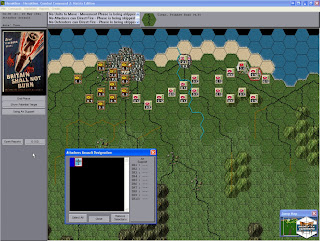The instruction manual that comes with Combat Command: The Matrix Edition is over 100 pages long. There’s no ‘tutorial’ levels and minimal in-game handholding. It’s a game that is resolutely 90s in concept and execution, but strategy buffs should lap it up.
 |
| Battles can literally take days to complete |
Combat Command is set in World War 2, and has an impressive scope – 42 scenarios recreating battles held in Europe, Africa, The Middle East, Asia and the Pacific. It’s possible to take control of every major force that took centre stage during the conflict. If that’s not enough for you, then there’s also a scenario editor and the ability to share scenarios with Matrix Games’ busy fanbase. Scenarios range from the small – just a few units on each side – right down to the truly epic battles that changed the course of World War 2.
The game itself has been designed as you would expect from a military board game – the engine even offers the ability to see each and every dice roll so you can see where results are coming from. The map is covered with hexes, with flat, coloured terrain representing the various environments you’ll be doing battle with. Units are represented by square “pieces,” with combat data printed on top. As someone who grew up enjoying these kinds of board games, the presentation is a fond hit of nostalgia.
 |
| The propaganda posters are a nice touch, but don’t expect much else in terms of presentation |
The converse to this is the game looks pretty plain if your cup of tea is usually something like RUSE. There’s little to no animation here, just square pieces sliding around a battle map, the resolution is low, and menus and fonts look like something from a game 15 years ago.
Of course, whichever side of the fence you sit on, the visuals are not the important part of this game (you’ll be wanting to read that 100 page rulebook). Combat Command relies on its strategy, and it does a good job of it too.
In each scenario you’ll be looking to either capture or hold strategic points. It’s not an easy matter, though – you’ll need to consider chains of command and supply lines, unit morale and troop quality. Where most modern strategy games have you killing enemy units with abandon, it’s a slightly different strategy here – units die relatively rarely. Instead, a forced withdrawal allows you to make a steady progress towards your objective.
 |
| Don’t let the visuals fool you, this is a complex, rewarding game |
I quickly became a fan of Combat Command’s system. It’s relatively streamlined for a military boardgame – but still deep enough that there are a number of different ways to approach objectives. Smart strategies will allow you to overcome a larger enemy – which is both historically accurate and a satisfying experience to play around with.
There’s no campaign option, and the only multiplayer mode available is the workable-but-unfashionable play by email. Compared to modern strategy epics such as Shogun: Total War, that’s a bit disappointing, but the developer, Boku Strategy Games, didn’t have that level of resources to work with.
And perhaps the developers there wouldn’t want to work on that scale of project, either. Combat Command is a game for a different kind of strategy gamer, offering a completely different level of strategy. I can only hope that people who read this review are willing to give the game a chance despite its niche nature because it’s a deeply intelligent game, and quite possibly something you’ve never experienced before.







